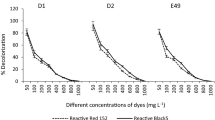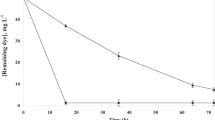Abstract
Halomonas sp strain GTW was newly isolated from coastal sediments contaminated by chemical wastewater and was identified to be a member of the genus Halomonas by 16S rDNA sequence analysis and physical and biochemical tests. The optimal decolorization conditions were as follows: temperature 30°C, pH 6.5.0–8.5, NaCl 10–20% (w/v) and the optimal carbon source was yeast exact. The results of experiments demonstrated that the bacteria could decolorize different azo dyes under high salt concentration conditions, and the decolorization rate of five tested azo dyes could be above 90% in 24 h. The exploitation of the salt-tolerant bacteria in the bio-treatment system would be a great improvement of conventional biological treatment systems and the bio-treatment concept.





Similar content being viewed by others
References
Bhatt M, Zhao J, Monteil-Rivera F, Hawari J (2005) Biodegradation of cyclic nitramines by tropical marine sediment bacteria. J Ind Microbiol Biotechnol. 32(6):261–267
Bromley-challenor KCA, Knapp JS, Zhang Z, Gray NCC, Hetheridge MJ, Evans MR (2000). Decolorization of an azo dye by unacclimated activated sludge under anaerobic conditions. Water Res 34:4410–4418
Brown MA, De Vito SC (1993). Predicting azo dye toxicity. Crit Rev Environ Sci Technol 23:249–324
Carliell CM, Barclay SJ, Naidoo N, Buckley CA, Mulholland DA, Senior E (1994) Anaerobic decolorisation of reactive dyes in conventional sewage treatment processes. J. Water SA 20:341–344
De Baere LA, Devocht M, Assche PV, Verstraete W (1984). Influence of high NaCl and NH4Cl salt levels on methanogenic associations. Water Res 18:543–648
EPA.(1997) Profile of the textile industry. Environmental Protection Agency, Washington, USA
Guo JB, Zhou JT, Wang D, Wang J, Yu H (2005) Decolorization of dye wastewater with high salt concentration by the Acclimatized salt-tolerant cultures. J Environ Sci 17(6):984–988
Hinteregger C, Streichsbier F (1997) Halomonas sp., a moderately halophilic strain, for biotreatment of saline phenolic waste-water. Biotechnol Lett 19(11):1099–1102
Hu TL (1998) Degradation of azo dye RP2B by Pseudomonas luteola. Water Sci Technol 38:299–306
Ivanova EP, Bakunina YI, Sawabe T, Hayashi K, Alexeeva YV, Zhukova NV, Nicolau DV, Zvaygintseva TN, Mikhailov VV (2002) Two species of culturable bacteria associated with degradation of brown algae Fucus evanescens. Microb Ecol 43(2):242–249
Manu B, Chauhari S (2003) Decolorization of indigo and azo dyes in semicontinuous reactors with long hydraulic retention time. Process Biochem 38:1213–1221
Moosvi S, Keharia H, Madamwar D (2005) Decolourization of textile dye Reactive Violet 5 by a newly isolated bacterial consortium RVM 11 1. World J Microbiol Biotechnol 21:667–672
Mufiel B, Wafa A, Vincent U, Thierry H (1999) DNA extraction from activated sludges. Curr Microbiol. 38:315–319
Pearcea CI, Lloydb JR, Guthriea JT (2003) The removal of colour from textile wastewater using whole bacterial cells: a review. Dyes Pigments 58:179–196
Seshadri S, Bishop PL, Agha AM (1994) Anaerobic/aerobic treatment of selected azo dyes in wastewater. Waste Manag 14:127–137
Acknowledgements
This study was supported by the Cross-Century Talent Fund of National Education Committee of China.
Author information
Authors and Affiliations
Corresponding author
Rights and permissions
About this article
Cite this article
Guo, J., Zhou, J., Wang, D. et al. A novel moderately halophilic bacterium for decolorizing azo dye under high salt condition. Biodegradation 19, 15–19 (2008). https://doi.org/10.1007/s10532-007-9110-1
Received:
Accepted:
Published:
Issue Date:
DOI: https://doi.org/10.1007/s10532-007-9110-1




